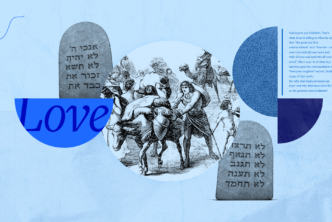When one looks at the Christian church today, depending on their experience and exposure, the first thing he or she may see is its divisions. Within Protestantism alone, the mere mention of issues like free will, predestination, foreknowledge, inerrancy, penal substitution, eternal subordination of the Son, and infant baptism can instigate debates filled with far more heat than light.
It can be easy to focus on these fissures amongst the faithful, to despair for the unity of the church. However, the history of the church is fraught with division, and with debate that was often far more vociferous than Twitter today—if you can believe that! And yet there was a period in the Greek-speaking church in which debate was finally settled and common ground became accessible.
Understanding and investigating these epochs within church history can do more than advance our knowledge of the past; they can also inform our actions in the present. And in this particular case, the method of the past was preserved in manuscripts of the New Testament.
A brief history of division
Leading up to the Council of Chalcedon (AD 451), the primary Christological debate was focused on the patriarch of Constantinople named Nestorius. He was appointed to the patriarchate in 428, but his teaching was condemned at the council in Rome as early as 430. Nestorius taught that for Christ to have two natures, these natures must be completely distinct. Essentially, the divine Logos and the human Jesus were two separate persons joined together at the moment of the incarnation. Leading the charge against Nestorius was Cyril, bishop of Alexandria (412–444). While formally anathematizing Nestorius at the Council of Ephesus (431), Cyril incorporated two Christological phrases that were later adopted into the Chalcedonian canons:
- μία φύσις τοῦ θεοῦ λόγου σεσαρκωμένη (mia phusis tou theou logou sesarkomene) “one incarnate nature of God the Word”
- ἐκ δύο φύσεων (ek duo phuseon) “out of two natures”
For Cyril, the Scriptures portrayed the incarnation as a type of “economic appropriation” wherein both divine and human natures of Christ subsisted in unity. They were not separate but conjoined in a cosmic way. Understandably, while Cyril’s phraseology was ultimately preferred to Nestorius’s, its vagueness left it open to abuse. By the time of Chalcedon, Cyril’s second phrase, ἐκ δύο φύσεων (ek duo phuseon), had necessarily been enhanced to read:
This Jesus Christ, the only-begotten Son must be confessed to be in two natures [ἐν δύο φύσειν; en duo phusein], unconfusedly, immutably, indivisibly, inseparably united, and that without the distinction of natures being taken away by such union, but rather the peculiar property of each nature being preserved and being united in one person and subsistence, not separated or divided into two persons, but one and the same Son and only-begotten, God the Word, our Lord Jesus Christ.
The same hypostasis enjoyed between the three persons of the Godhead serves as the example of the hypostatic union of the incarnation of the Second Person of the Trinity.
While the Chalcedonian definition silenced a variety of heretical views, it was insufficient to unify the plurality of Christologies at the margins of orthodoxy. Figures like Theodoret of Cyrrhus and John Chrysostom1 maintained a strict form of Dyophysitism which, while rejecting the extremes of Nestorius, still maintained an autonomous view of Christ’s human nature. This group considered their beliefs to coincide with Chalcedon, and especially Cyril’s “of two natures,” properly understood. Elsewhere, Monophysites like Severus of Antioch, maintained that Christ’s natures were joined in such a way as to make them one without discernment, and that they held to a proper understanding of Cyril’s formula. Severus believed that the council’s adjustment of the phrase to read “in two natures” created division within the being of Christ.
Efforts at reconciliation post-Chalcedon failed, but eventually, in the sixth century, there arose a middle way. This position, called Neo-Chalcedonianism, obtained the approval of Emperor Justinian I and sought to unify the teachings of Cyril with the confession of Chalcedon in such a way that all could maintain their doctrinal stances without suffering anathema. The Neo-Chalcedonians argued that the council’s addition of ἀσυγχύτως (asunchutos, unconfused) and ἀδιαιρέτως (adiairetos, undivided) to the formula allowed for distinction of natures without separation into different entities; yet the council also knew that Cyril’s use of “one incarnate nature” could not withstand Eutychian Monophysitism, 2 and thus required the addition of πρόσωπον (prosopon, person). While not strictly Cyrillian language, it was argued that by joining “person” with “hypostasis,” it retained the ipsissima vox (the same “voice” or idea) of the Alexandrian bishop. By arguing that Antiochene Dyophysites and non-Eutychian Monophysites could retain their Christological particularities without violating the Chalcedonian creed, and by having imperial support, neo-Chalcedonianism grew. After centuries of polemical infighting, the church desired peace within the body above all else, and this synthesized theology became the vehicle for its achievement. Evidence of its promulgation is found in the unique form of commentary manuscripts known as catenae.
Catenae
Beginning sometime in the sixth century, a form of commentary manuscripts known as catenae were introduced into the exegetical world of the Byzantine Empire. A catena differs from the standard, single-author commentary by being comprised of short, edited extracts taken from various patristic authors and strung together in the form of a “chain” (catena in Latin) commentary. These multi-author commentaries are believed to have begun with Procopius of Gaza, who produced a catena on the Octateuch.
Catenae on the New Testament are believed to have begun in or around the seventh century, beginning with the Gospels and followed thereafter by the Pauline and Catholic epistles. These “chains” of patristic extracts in some manuscripts surround the biblical text along the upper, outer, and lower margins of the folio in a frame format, while others adopt an alternating format aesthetically similar to single-author commentary manuscripts. Scholia (marginal notations) are often identified with names or sigla (signs, such as an asterisk in contemporary English) representing the source, among whom are Origen, John Chrysostom, Severian of Gabala, Severus of Antioch, Theodoret of Cyrrhus, Oecumenius, and others.

Catenae in Paul
A striking feature of catenae is the inclusion of voices from disparate areas of the orthodox church, alongside anathematized heretics. It is notable that Theodoret of Cyrrhus, condemned at the Second Council of Constantinople, rests alongside John Chrysostom and the anathematized Severus of Antioch. Yet, in some catenae, the inclusion of these questionable voices is explained by way of a Cyrillian preface, taken from Cyril of Alexandria’s Letter to Eulogius, wherein Cyril explains that the inclusion of heretics is acceptable inasmuch as they often say things that are comparable to the orthodox faith. Using Cyril as the figurehead for the catena intimates that their text subscribes to Cyrillian belief, thus making it acceptable. However, the fact that the patristic extracts are conjoined reveals a larger attempt at uniting the church under the banner of Neo-Chalcedonianism, and it provides contemporary Christians with an insight into how the Church navigated ecclesial-theological conflict in a way that legitimized differences without compromising doctrinal essentials.
As it pertains to the various catena traditions of the Pauline epistles, the most prolific is ascribed to a sixth-century figure named Oecumenius. Whether this catena was actually created by Oecumenius is an ongoing matter of debate, but at the time of its circulation, at least several scholia within it were believed to be from him. Oecumenius was a Monophysite in correspondence with Severus of Antioch, who referred to him as a “careful and very orthodox (Monophysite) man,” evidenced in the following scholia. At Ephesians 1:17 Oecumenius writes:
St. Gregory in his oration on the Son, I think, took the two titles to apply to Christ: “Father” of the Word; “God” of that which was assumed. He did this so that you might receive Emmanuel both from divinity and humanity in one nature.
At Ephesians 4:13 he explains what the author of Ephesians meant by maturing in the “full stature of Christ”:
He says the “full stature of Christ” meaning complete faith and knowledge of Christ. Teachings like that he received flesh from the Virgin; that he is divine and human in one nature.
At Colossians 2:9 he writes that the fullness of deity in bodily form is not to imply that God changed habitations, but that
“in bodily form” means the incarnation, having furthermore one nature along with his own flesh, even if he subsists in two opposites.
Lastly, at Hebrews 1:4, speaking of the superiority of Christ, he writes:
Christ who along with his flesh is worshipped in one nature.
For a Monophysite, the communication of Christ’s one nature is indicative of the union of divinity and humanity after the incarnation, and any hint of division between the humanity and divinity of Christ was anathema, explicitly concerning the Antiochene Dyophysites. What complicates the existence of Monophysite scholia in catena manuscripts is that most of the other comments come from committed Dyophysites like John Chrysostom and Theodoret of Cyrrhus. In contrast to the Monophysites, they maintained a unity within the incarnation, but not one that blurred the humanity of Christ. So insistent were they on this matter that their exegesis, at times, appears to pit the humanity against the divinity. Therefore, while Chrysostom in his scholia will mention the one nature of Christ, he and Theodoret understand it in ways completely divergent from that of Severus or Oecumenius.
How, then, can such disparate views be legitimately reconciled within the body of manuscripts like these? The answer is in Cyril of Alexandria. In the catena of Hebrews, we read at Hebrews 1:3 that Cyril believed Jesus’s being the “radiance” to:
reveal the generation from the Father … but in no way being removed from His nature.
Later, at Hebrews 1:8 we read from Cyril again, saying:
In the incarnation, God shared in creation, uniting creation to himself.
With the added note that Gregory of Nyssa also wrote of this in his work Against Eunomius. And, at Hebrews 2:10 the catenist writes that Christ had to suffer in order to
complete humanity in himself through the suffering and resurrection, as both Cyril and Severus taught.
Several theological moves are made here. First, Cyril’s use of nature is one that both Monophysites and Dyophysites subscribed to, though each disagreed that the other could do so legitimately. The Monophysites rejected Chalcedon’s appropriation of Cyril and claimed to understand him better. The Dyophysites accepted the Chalcedonian definition as authentically Cyrillian. Bringing Cyril into the body of the catena in this way bonds both positions using common language. Second, Cyril is said to agree with Gregory of Nyssa in his Christology, linking the bishop of Alexandria back to the Cappadocians—an important confirmation of his orthodoxy. Third, Cyril and Severus are said to be in agreement. In fact, regarding Heb. 2:10 and the need for Christ to experience human suffering in order to make humanity perfect, they do agree, as is evident in Cyril’s work On the Unity of Christ and Severus’s letter Against Julian of Halicarnassus. In making these moves, the catenae present a perceived unity of Cyrillian theological belief.
Conclusion
While I say that this unity of belief is “perceived,” it is worth pointing out that it wasn’t entirely false. The very core of Neo-Chalcedonian theology was finding a means to unite all parties around Chalcedon by excluding the heretical extremes that existed on the boundaries of each. This was only possible by using the one figure all claimed as their own, Cyril of Alexandria. In reality, Severus himself was a rather conservative Monophysite, rejecting the heresies of Eutychianism while simultaneously rejecting Chalcedon. If Oecumenius was approved by him, that would suggest that he, too, was of the Severan persuasion. Similarly, Chrysostom rejected the heretical Nestorianism while maintaining a division of sorts within the incarnate nature. Both representatives could be used as figureheads of their respective theological bases, and because both legitimately professed a Christology that could be defined along Cyrillian lines, he became the mortar needed to build the walls of the Neo-Chalcedonian church.
While it can be all too easy to look at this style of commentary and this period of the church’s history with cynicism, it is important to recognize that these manuscripts and the rise of Neo-Chalcedonianism reflect a period in the church where unity was desired above all else, and those things that could be forgiven theologically were. It was not a unity built on doctrinal compromise, but a unity built on the essential doctrines of the faith—and a unity that was able to extend grace to those whose understanding of those doctrines was nuanced differently. Catenae not only give the modern church access to our ecclesial past by preserving the text of the New Testament, but their providential preservation of these harmonized theological controversies can provide the body of Christ with tools to navigate present conflicts in a way that honors both our brothers and sisters in Christ and our Lord.
Related resources
- Chrysostom preceded Cyril and the Council in life, but his teaching and theology remained the most prolific for many centuries.
- So named for its proponent Eutyches of Constantinople. He argued that the humanity of Christ after the incarnation was overwhelmed by the divinity in the same way a drop of vinegar is consumed by an ocean.







